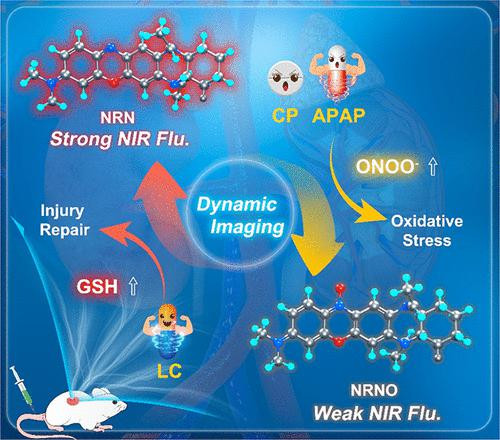Our official English website, www.x-mol.net, welcomes your feedback! (Note: you will need to create a separate account there.)
Redox-Reversible Near-Infrared Fluorescent Probe for Imaging of Acute Kidney Oxidative Injury and Remedy
ACS Sensors ( IF 8.9 ) Pub Date : 2023-02-15 , DOI: 10.1021/acssensors.2c02610 Yiteng Ding 1 , Rongbin Zhong 1 , Renfeng Jiang 2 , Xuefeng Yang 1 , Longwei He 2, 3 , Lin Yuan 3 , Dan Cheng 1, 3
ACS Sensors ( IF 8.9 ) Pub Date : 2023-02-15 , DOI: 10.1021/acssensors.2c02610 Yiteng Ding 1 , Rongbin Zhong 1 , Renfeng Jiang 2 , Xuefeng Yang 1 , Longwei He 2, 3 , Lin Yuan 3 , Dan Cheng 1, 3
Affiliation

|
Drug-induced acute kidney injury (DIAKI) is associated with high morbidity and mortality. It remains a diagnostic and therapeutic dilemma due to failure of providing unambiguous real-time feedback on nephrotoxicity, which is regarded as a serious problem in clinics. Herein, we report a reversible fluorescence probe, NRN, to monitor the ONOO–/GSH in an acute kidney injury model. The NRN near-infrared fluorescent probe features a big Stokes shift (83 nm), which was oxidized by ONOO– and reduced by succussive glutathione (GSH) with excellent selectivity and good sensitivity (detection limit: 418 nM and 0.28 mM, respectively). Taking the reversibility of NRN toward ONOO– and GSH, real-time evaluations in vivo with cisplatin (CP) alone and CP combined with acetaminophen-stimulated acute kidney injury and the following remedy process with l-carnitine were realized for the first time. The experiments revealed that acute kidney injury caused by combined drugs might be more serious and irreversible under certain conditions. Therefore, NRN could act as a potential tool for understanding oxidative stress-related DIAKI disease processes.
中文翻译:

氧化还原可逆近红外荧光探针用于急性肾氧化损伤的成像及治疗
药物引起的急性肾损伤 (DIAKI) 与高发病率和死亡率相关。由于未能提供关于肾毒性的明确实时反馈,这仍然是一个诊断和治疗的困境,这在临床上被认为是一个严重的问题。在此,我们报告了一种可逆荧光探针NRN ,用于监测急性肾损伤模型中的ONOO - /GSH。NRN近红外荧光探针具有较大的斯托克斯位移 (83 nm),可被 ONOO 氧化,并被连续的谷胱甘肽 (GSH) 还原,具有出色的选择性和良好的灵敏度(检测限分别为 418 nM 和 0.28 mM)。考虑NRN对 ONOO的可逆性——和GSH,首次实现了单独使用顺铂(CP)和CP联合对乙酰氨基酚刺激的急性肾损伤的体内实时评估以及随后的左旋肉碱治疗过程。实验表明,联合用药引起的急性肾损伤在一定条件下可能更为严重且不可逆。因此,NRN可以作为理解氧化应激相关 DIAKI 疾病过程的潜在工具。
更新日期:2023-02-15
中文翻译:

氧化还原可逆近红外荧光探针用于急性肾氧化损伤的成像及治疗
药物引起的急性肾损伤 (DIAKI) 与高发病率和死亡率相关。由于未能提供关于肾毒性的明确实时反馈,这仍然是一个诊断和治疗的困境,这在临床上被认为是一个严重的问题。在此,我们报告了一种可逆荧光探针NRN ,用于监测急性肾损伤模型中的ONOO - /GSH。NRN近红外荧光探针具有较大的斯托克斯位移 (83 nm),可被 ONOO 氧化,并被连续的谷胱甘肽 (GSH) 还原,具有出色的选择性和良好的灵敏度(检测限分别为 418 nM 和 0.28 mM)。考虑NRN对 ONOO的可逆性——和GSH,首次实现了单独使用顺铂(CP)和CP联合对乙酰氨基酚刺激的急性肾损伤的体内实时评估以及随后的左旋肉碱治疗过程。实验表明,联合用药引起的急性肾损伤在一定条件下可能更为严重且不可逆。因此,NRN可以作为理解氧化应激相关 DIAKI 疾病过程的潜在工具。



























 京公网安备 11010802027423号
京公网安备 11010802027423号